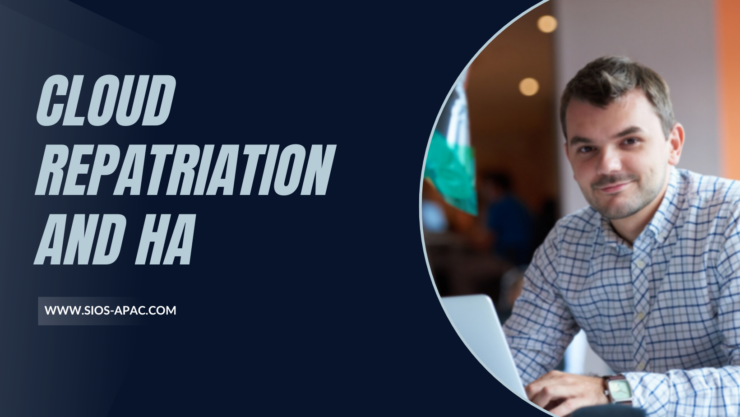Cloud Repatriation and HA
There is a small but growing media buzz about a phenomenon called “cloud repatriation”. In simple terms, cloud repatriation means taking your workload from the public cloud and bringing it back to your own data center. This move could potentially boost the demand for on-premises equipment, such as servers, storage, and networking gear. It could also ramp up the need for solutions that make it easy to manage both on-premises and cloud-based resources. For companies running critical workloads in the cloud, repatriation could have significant impact on the ways they deliver high availability protection. It’s worth noting that the impact of cloud repatriation on the high availability market depends on a few things, like why organizations are choosing to go back to on-premises data centers, as well as other industry trends and competition. So why might organizations opt to leave the cloud?
Common Reasons for Cloud Repatriation
Cost: Running workloads in the cloud can be expensive and costs can be unpredictable, especially if an organization’s usage patterns and requirements change over time. Repatriating workloads back on-premises can help organizations reduce costs, particularly if they have unused capacity or can leverage existing infrastructure. It can also help make IT budgets more predictable.
Data sovereignty: Some organizations may be subject to regulation that dictate what country their data is stored in, who has access to it, and how it is protected. Repatriating workloads can give organizations more control over their data and help them comply with data sovereignty laws and regulations.
Security: Organizations may have security concerns about running workloads in the cloud, particularly if they handle sensitive data or are subject to strict regulatory requirements. While clouds have a variety of security measures, misconfguration is common and can result in security issues. By eliminating the need for cloud-specific knowledge, repatriating workloads can give organizations more control over their security posture.
Latency: Cloud providers may be located far from the organization’s users, which can result in higher latency and slower response times. Repatriating workloads back on-premises can help organizations reduce latency and improve performance for their users.
Control: While moving to the cloud saves companies the cost of IT infrastructure management, these savings come at the cost of control. Cloud providers manage and maintain the IT environments according their own schedules. Companies who repatriate their data centers regain complete control over their infrastructure, upgrades, updates, and maintenance. .
Lack of Cloud Provider’s specific service or feature: Organizations may find that a particular service or feature is not available in the public cloud, and thus they might decide to repatriate the workload back on-premises.
Please note that there could be other additional factors at play, but it’s crucial to keep in mind that these reasons may differ based on the organization’s industry and unique needs.
High Availability in the Context of Public Cloud Repatriation
For years, the public cloud has been popular as businesses flock to cloud-based solutions for their computing needs. But according to a recent InfoWorld [link to article] article, we might see a shift in 2023 as companies start to bring their data and workloads back in-house or to private clouds. One major reason for this move is the desire for greater availability and control over infrastructure.
High availability (HA) is a critical aspect of modern IT infrastructure, ensuring that applications and services remain accessible and operational even in the face of hardware failures, software bugs, or other unforeseen events. In a public cloud environment, high availability is typically achieved through a combination of redundant infrastructure and automatic failover mechanisms, such as load balancing and auto-scaling.
However, some businesses may find that the level of control they have over their cloud infrastructure is limited, and they may have concerns about data security, compliance, and vendor lock-in. These concerns can lead to a desire to bring workloads and data back on-premises or to private clouds.
How a Hybrid Cloud Model Can Solve Problems
One potential solution to these concerns is to adopt a hybrid cloud approach, where businesses leverage the best of both worlds by combining the scalability and flexibility of the public cloud with the control and security of on-premises or private cloud infrastructure. Hybrid cloud architectures can be designed to provide high availability by replicating data and services across multiple locations, both on-premises and in the cloud.
Implementing a hybrid cloud architecture requires careful planning and design, with a focus on ensuring that workloads and data are distributed in a way that maximizes availability while minimizing latency and other performance issues. Some key considerations include selecting the appropriate cloud providers and on-premises infrastructure, ensuring that data is replicated and synchronized effectively, and designing failover mechanisms that can handle both planned and unplanned outages.
Another important consideration is the need for effective monitoring and management of the hybrid cloud environment. This includes implementing automated monitoring tools to detect and respond to outages, ensuring that backups are regularly performed and tested, and establishing clear processes and procedures for handling incidents and disasters.
SIOS High Availability Solutions
So, while public cloud adoption has been on the rise for several years, concerns about control, security, and availability are leading some businesses to consider repatriating workloads and data to on-premises or private cloud environments. A hybrid cloud approach that combines the scalability and flexibility of the public cloud with the control and security of on-premises infrastructure can be an effective way to address these concerns while maintaining high levels of availability. In short, nailing a hybrid cloud setup takes serious prep work and know-how. Luckily, SIOS High Availability Solutions has got you covered. We invite you to learn more about our tools and services so you can confidently navigate your hybrid cloud journey.
Reproduced with permission from SIOS
